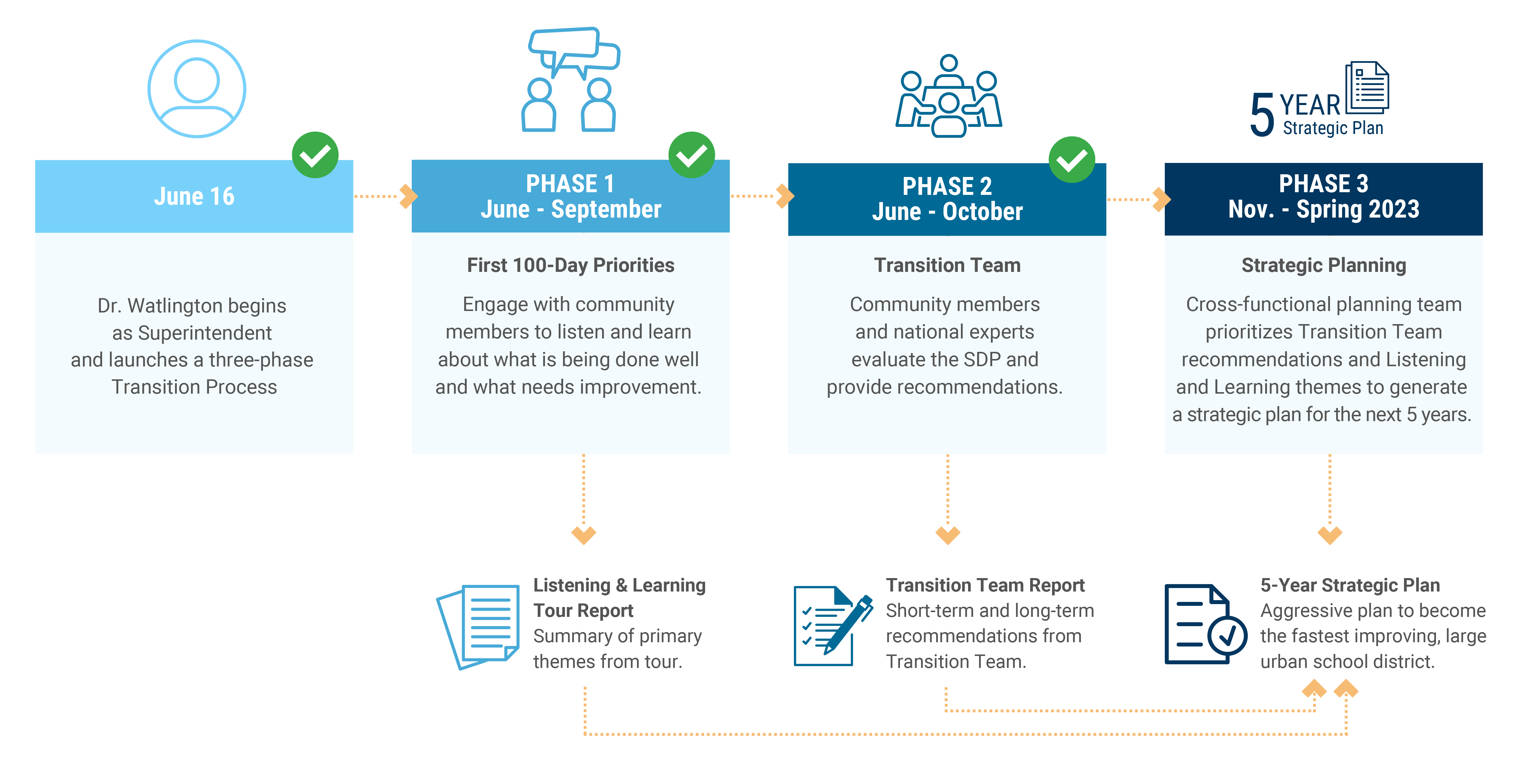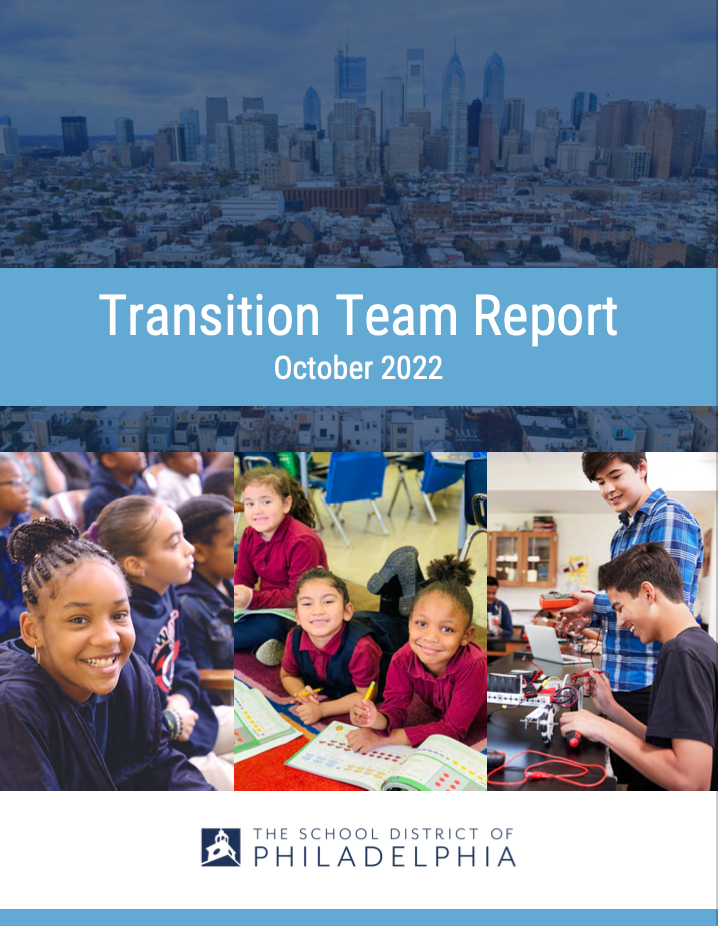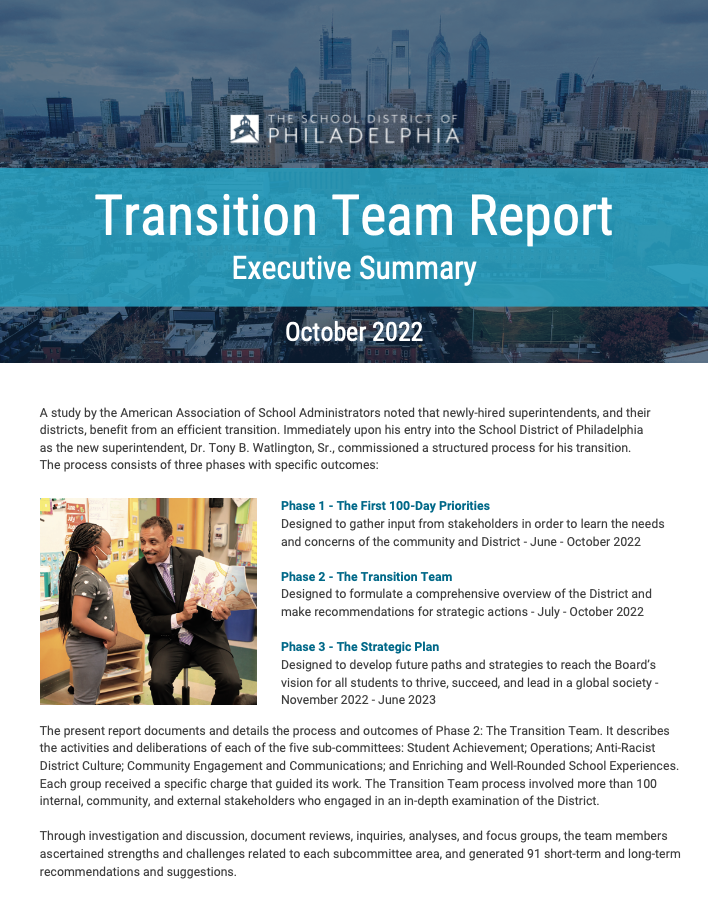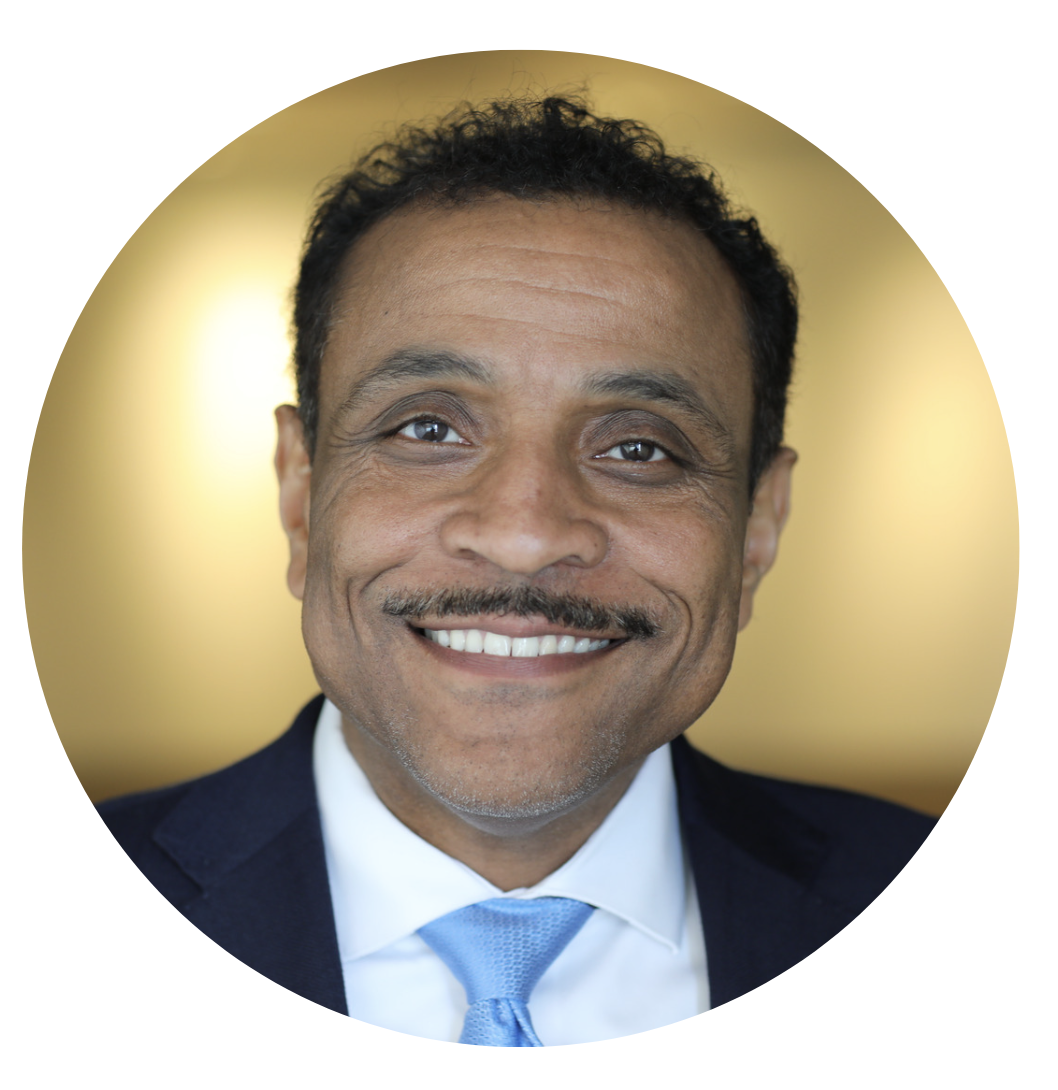
Superintendent Transition
A Message from Superintendent Watlington
Since starting as Superintendent for the School District of Philadelphia in June 2022, in keeping with my collaborative, results-oriented leadership style, I have been engaging in a comprehensive process to ensure a smooth transition. This three phase process will inform how we move forward together to become the fastest improving large, urban school district in the country. During Phase 1, my top priority was to listen and learn. I committed to listening from people across Philadelphia to learn what the District does well, what needs improvement, and how we can work collaboratively. Phase 1 of my transition process concluded at the end of September. Phase 2 was the Transition Team which conducted an evaluation of the current strengths and challenges of the District. This report, presented in October 2022, provided objective information and recommendations to guide my immediate and future actions. The final Phase of my transition is the development of a 5-year Strategic Plan, which will be presented in spring 2023.
Updates
Phase 3: Strategic Planning
Phase 3 of the Transition Process, creating a 5-year Strategic Plan, began in November. As part of the Strategic Planning process, we will use the learnings and recommendations from Phases 1 and 2 of the transition process–as well as the experiences of our talented school leaders, staff, students, and families–to develop a comprehensive, actionable plan that will serve as a roadmap for our next 5 years. It is through the implementation of this plan that we will position ourselves to become the fastest improving large, urban school district in the country.
The Strategic Planning process will consist of 6 primary stages, resulting in the launch of the plan by June 2023. Throughout all stages of the process, the experiences and insights of District staff, school leaders, educators, school-based staff, students, and community members will be uplifted. This work will be driven by the following teams representing the wide variety of perspectives and diverse experience of our District community:
- Leadership Team: Group of 25 central office and school leaders that serve as the decision-making body for the Strategic Plan.
- Steering Committee: Group of 50 central office staff, school-based staff, and students from across Philadelphia that generates the content of the Strategic Plan which is reviewed by the Leadership Team.
- Advisory Groups: Groups of community members who provide critical insights and feedback as pieces of the Strategic Plan are developed. The Steering Committee will engage Advisory Groups of parents/guardians, principals, teachers, school support staff, students, union leadership, and central office staff.
Phase 2: Transition Team
Dr. Watlington’s core focus is to improve outcomes for all of our diverse learners and achieve the Board’s Goals & Guardrails, such that the School District of Philadelphia is positioned to be one of the nation’s fastest improving urban districts. The Transition Team is phase 2 of a three-phase effort designed to lay a strong foundation for transformative growth for our students.
To effectively assess a District this size and this complex as quickly as possible, we must be strategic, intentional and inclusive. The Transition Team is intentionally constructed to harness the collective power of more than 100 members of the Philadelphia community – including Philadelphia parents, teachers, principals, unions, educational, city, business, non-profit and grassroots leaders, and SDP staff – together with non-SDP education and industry leaders to assess five key areas of our District (Student Achievement, Operations, Anti-Racist District Culture, Community Engagement & Communications, and Enriching & Well-Rounded School Experiences) and make short-term and long-term recommendations to drive sustainable improvements in those areas.
Recommendations from the Transition Team and insights from Phase 1 Listening and Learning sessions will inform Phase 3, the development of a new strategic plan.
Transition Team Report
The Transition Team Report was presented to the Board of Education and the public on October 20, 2022. Transition Team Co-chairs Andrea Custis and Dr. Guy Generals shared the findings of the sub-committees and their 91 recommendations.
Phase 1: First 100 Day Priorities
During Phase 1, Dr. Watlington’s top priority was to listen and learn. He focused this work around five key priority areas. He successfully completed all of the first 100-day priorities as outlined.
A majority activity within Phase 1 was the Listening and Learning tour. Dr. Watlington hosted 90 Listening and Learning sessions that included educators, school leaders, students, family members, central office and school-based staff, citywide groups, and community-based organizations.
Read more about the results from the Listening and Learning Sessions.
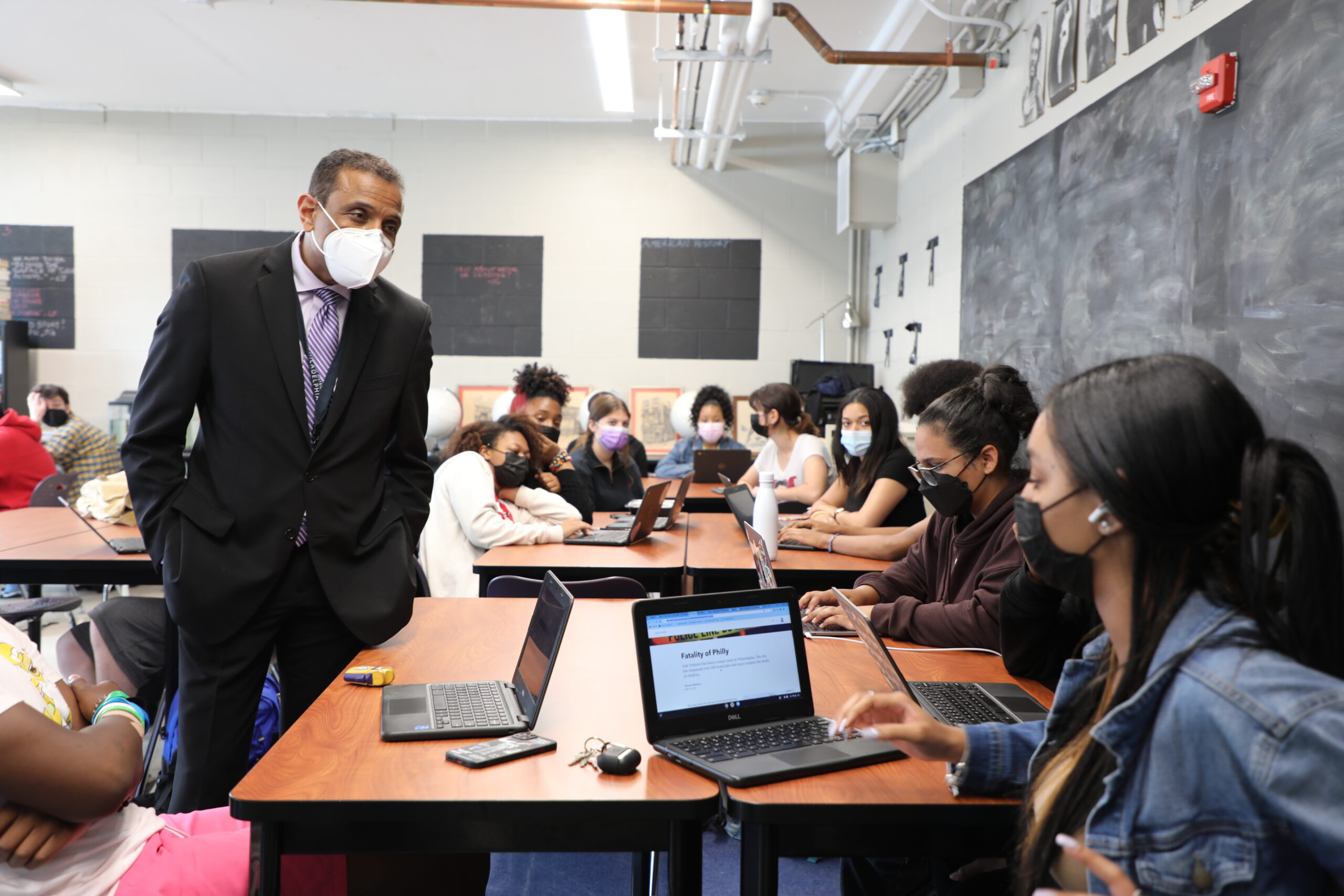

Priority Area 1
Assess Student and Staff Well-Being
The Goal
Students and staff cannot flourish if they are not physically or emotionally safe. As a school district, we must approach issues of well-being and safety as a collaborative effort, convening key stakeholders from the Mayor’s office, City Council, the business community, our neighborhoods, and our schools to create a safety net for students and staff to learn and grow. Our approach to student well-being and safety will offer our students an invitation and access to increased opportunities to engage in healthy, meaningful activities which will help them foster positive mindsets. We will work to ensure that our students see the wealth of opportunities Philadelphia offers them to become productive citizens.
Action Steps
1.1 Hire a community liaison that reports to the Superintendent to coordinate grassroots communication and responses to community issues, including student and staff safety issues.
1.2 Review the structures in place to convene key city and community leaders around issues of chronic absenteeism, homelessness, emergency supports, and out-of-school time.
1.3 Assess possibilities to expand summer, after-school, and co-curricular programming activities in collaboration with city agencies, grassroots organizations, and key stakeholders.
1.4 Review how we receive feedback and respond to feedback from students, staff, parents, and community members regarding school climate and school safety issues.
1.5 Review and assess our school/district suspension and expulsion data, with a particular focus on violent offenses within and around our schools.
1.6 Review individual school climate data.
1.7 Review our approach to student and staff mental health support and determine whether we are appropriately investing in coordinated mental health supports and services for students and staff.
1.8 Assess the investments that have been made to restorative practices and positive behavior, intervention, and support programs.

Priority Area 2
Engage Our Stakeholders and Build Trust
The Goal
Building trust starts with listening to understand, and then collaborating and communicating effectively as partners in the work of helping all students succeed. It is essential for us to understand the hopes and dreams of our community, including students, families, staff, city and state leaders, unions, universities, activists, grassroots organizations, and business leaders. In addition, we must ensure that we have strong, collaborative structures and evaluate how we are communicating internally and externally.
Action Steps
2.1 Launch a listening and learning tour to understand the exact priorities and needs of all communities.
2.2 Increase collaborative structures with the Superintendent.
2.3 Meet with key leaders in consultation with the Board of Education President and Vice President, Mayor, City Council, state officials and legislative delegation, faith-based community, business leaders, and community members.
2.4 Host town hall sessions in-person and via Zoom meetings with teachers, administrators, support staff, other school-based staff, and central office employees to understand what is working and what are areas of stress/anxiety.
2.5 Initiate discussions and communicate with our union partners to establish a culture of respect and trust.
2.6 Evaluate internal communication protocols, including social media strategy, to determine how system-wide messages are understood by board members, principals, instructional staff, non-instructional staff, and central office staff.
2.7 Schedule Board of Education retreats to review communication protocols, year 1 priorities, and the superintendent evaluation process.
2.8 Assess the current state of the district’s communication and engagement efforts, as well as evaluate the quality of the school district website and schools’ websites.

Priority Area 3
Assess Teaching and Learning
The Goal
Teaching and learning that results in improved academic achievement and reaching the Goals and Guardrails is our core work. Covid-19 has caused serious disruption in student learning, and we must now begin to strengthen coherence in our instructional program to ensure that our teachers and schools have what they need to prioritize high-quality teaching and learning. Ensuring that all students not only graduate from The School District of Philadelphia but are also college and workforce ready is the goal and responsibility of all district employees, contractors, and volunteers.
Action Steps
3.1 Develop a process for frequent and structured school visits to observe and support school improvement efforts.
3.2 Assess the current process of school improvement planning (including School Improvement Plans) and ensure that schools have a clear multi-tiered system of support for students.
3.3 Assess current professional development efforts to support administrative, instructional, and non-instructional staff and how the budget emphasizes an investment in staff development.
3.4 Assess the coherence of the district’s academic frameworks.
3.5 Focus on areas of academic under-performance and ensure strategies are in place to address root causes of student achievement trends.
3.6 Determine how comprehensive and research-based the current curricula are and to what degree they are aligned to standards and allow for student achievement/growth.
3.7 Assess student and staff attendance rates, student drop out rates, and student graduation rates to support progress toward the Goals and Guardrails

Priority Area 4
Assess District Leadership Capacity and Alignment
The Goal
It is essential for The School District of Philadelphia to have a high-performing, collaborative, and results-oriented culture. To make sure that we operate as a highly effective team with a professional culture, we will be intentional about assessing and building the capacity of our leadership to achieve the Goals and Guardrails. As author Jim Collins states, we will ensure that we have the right people on the bus and in the right seats. We will not get to excellence by accident. It will be by design.
Action Steps
4.1 Conduct one-on-one interviews and review resumes and briefing papers with all direct reports.
4.2 Administer leadership assessment inventories to get to know executive leadership better.
4.3 Establish a transition team comprised of members of the Philadelphia public school community, local leaders and K-12 national experts.
4.4 Conduct a retreat with senior staff to review the district’s priorities, most recent achievement data, review current and anticipated vacancies, and discuss leadership team structures and practices.
4.5 Review current office structure, alignment, and capacity to achieve the Goals and Guardrails.
4.6 Assess the autonomy and authority of school leaders (Principals) in the current organizational structure.
4.7 Plan a second retreat with senior staff to review accountability plans and organizational structures to achieve the Goals and Guardrails.

Priority Area 5
Assess District Operations, Facilities and Finances
The Goal
To meet the needs of all students in The School District of Philadelphia, it is critical that operations and finance align with Board policy, and represent excellence and transparency. Each division will be appraised to determine how they maximize support and services to schools using a continuous improvement model. Additionally, we will assess the depth of our facilities issues.
Action Steps
5.1 Conduct one-on-one meetings with direct reports on operations, human resources, and budget, including use of ESSR funds and how local, state, and federal grants are being utilized and evaluated.
5.2 Review the district’s fund balance, financial projections, resource allocation and budgeting processes; assess how the district’s budget and budget process are aligned to support student achievement.
5.3 Conduct one-on-one meetings with the Office of General Counsel to review any recent/current legal proceedings or outstanding judgments against the district and to provide a briefing on state education code with attention to statutes currently impacting or likely to impact the district.
5.4 Review the assessments of the District’s facilities conditions and actions to determine alignment with improving student achievement guided by the Goals and Guardrails and the facilities planning process.
5.5 Receive an update on any foundation activities and how those funds support schools.
5.6 Review key district financial materials, budget, most recent audit, grants, and any other reports and audits provided by the Office of the Inspector General and Board’s Office of Auditing Services.
5.7 Review current labor contracts and schedules.
5.8 Assess the extent to which the District balances the centralization of budgets and services.
New Appointments

Uri Monson, current Chief Financial Officer and former CFO in Montgomery County and Executive Director of the Pennsylvania Intergovernmental Cooperation Authority, will now serve as Deputy Superintendent of Operations.

Shavon Savage, a former principal and special education teacher in the School District of Philadelphia, who holds a superintendent’s certification and law degree, will serve in the new position of Deputy Superintendent of Academic Services.

Alexandra Coppadge, who currently serves as Chief of Communications at Mastery Schools and previously served as Executive Director at PECO here in the city and Director of Communications & Press Secretary for the City of Wilmington, Delaware, will now serve as Chief of Communications and Customer Service.
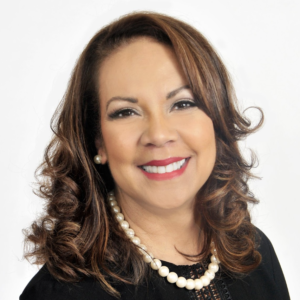
Monique Braxton, an Emmy Award-winning storyteller and communication leader – who families across Philadelphia invited into their homes for almost 20 years – will serve as Deputy Chief of Communication and District Spokesperson.
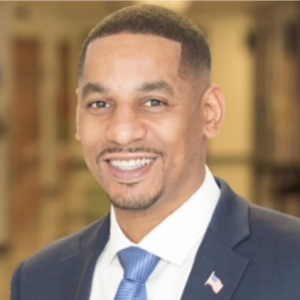
Edwin Santana, a community and political organizer, and former math and special education teacher and after school provider, will serve as Director of Community Relations, and will lead grassroots community engagement efforts.

